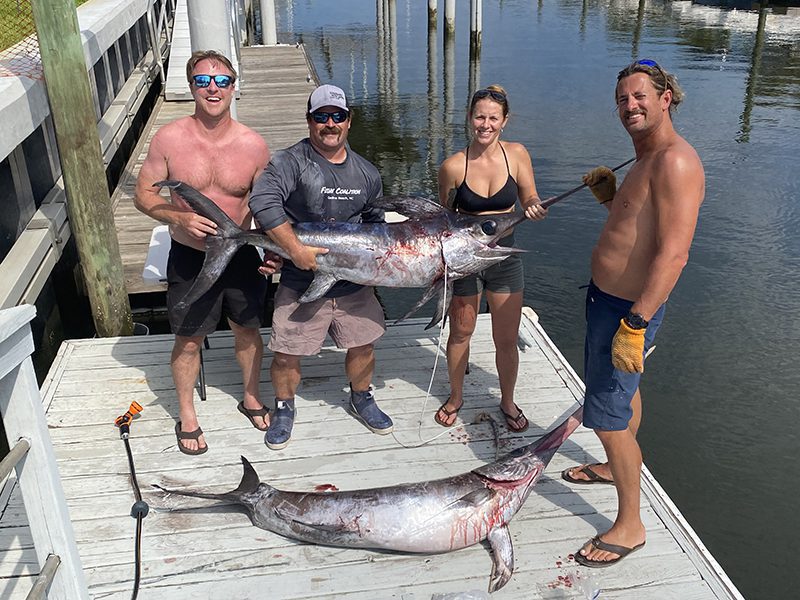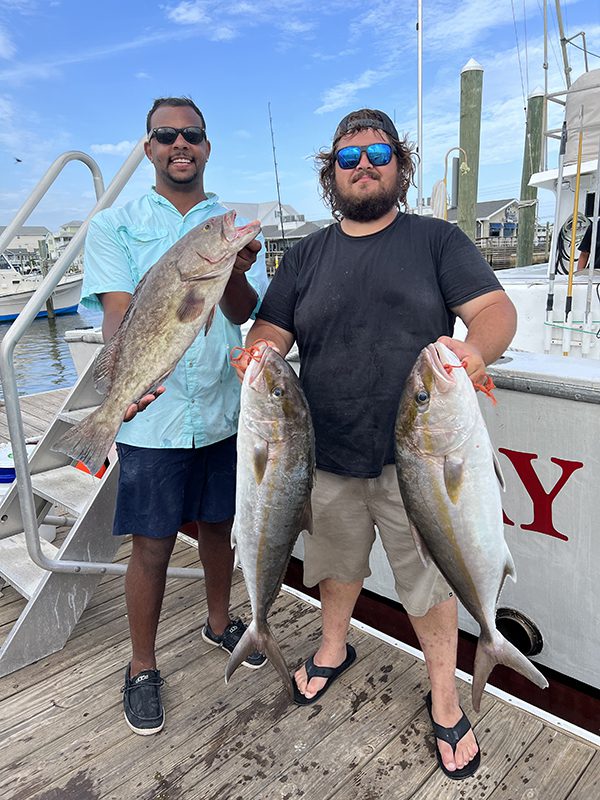Carolina Beach – September 2022
Lewis, of Island Tackle and Hardware, reports that surf anglers have had the most success while bottom fishing, with catches of croakers, pinfish, flounder, and the occasional pompano. Those rigged with cut baits have also landed a few sharks in the surf.
Inshore anglers fishing from the ICW back into the Cape Fear River have been enjoying scattered red drum and tons of flounder. Bottom-rigged live baits have been producing most of this action.
Some good-sized sheepshead and scattered black drum are being caught with live shrimp fished around bridges, docks, and oysters.
Nearshore anglers have been finding hit or miss action on both spanish mackerel and kings while trolling live baits off the beach.

Ben Ray, Dan Bowman, Sam Flounders, and Jason White hooked these swordfish by deep dropping a spanish mackerel 74 miles southeast of Carolina Beach. They were fishing on the Fishin Coalition.
Christian, of Seahawk Inshore Fishing Charters, reports that red drum action is picking back up, with anglers catching mixed bags of both lower-slot and upper-slot fish. Finger mullet or fresh dead shrimp have been the top producing baits. Target areas with shell bottoms or grass points depending on the tide cycle you are fishing.
Anglers are catching a good number of flounder on live baits while fishing for these reds. This is mostly a 16-20” class of flatfish that are staged up around creek mouths and grass banks with flowing water.
A few black drum are showing up with cooler temperatures around. Live or dead shrimp fished in the same areas listed above have been producing strikes.
Luke, of Spot On Charters, reports that the red drum bite has been hot, with plenty of bait moving around in the river. Anglers are having a lot of success casting Carolina-rigged mullet or drifting bait under a popping cork.
Anglers are also catching plenty of flounder in both good sizes and numbers while using the same tactics for reds.
A few speckled trout are showing up in the action, especially when fishing early in the morning.
Tommy, of Mungo Fishing Charters, reports that red drum action remains strong in the area, with good-sized bait now moving around. Windier conditions have demanded more live or cut bait fishing to get a strike. Mullet or pogies on a Carolina rig with lighter (1 oz.) weights have worked well when cast against grass edges or into deep holes.
Topwater plugs have also had plenty of success, and the target areas for this tactic have been shallow flats and grass edges over oyster bars.
Some speckled trout are also in the mix, especially for anglers fishing D.O.A. and similar artificial baits around areas of structure with good current.
Black drum are around for anglers fishing fresh dead shrimp on Carolina rigs. Look for areas with a little current stream moving around structure, as these areas seem to draw in the black drum.
Anglers are catch-and-releasing a lot of flounder when fishing live baits or the standard Gulp shrimp.
Mason, of Grand Slam Fishing Charters, reports that the red drum bite has been great, bait has been plentiful, and water temperatures are generally staying down. On higher tides, anglers are having success targeting oyster points and coves with water in the 2-4’ range. On lower tides, dropping back into deeper water and channels where fish can congregate helps keep on the action. Billy Bay slip bobbers rigged with live mullet are great on higher tides, and then use the same mullet on a Carolina rig for lower tides. Bigger mullet has generally led to bigger reds.
Anglers will find flounder action by targeting creek mouths on falling tides with Carolina-rigged finger mullet. For bigger flatfish, look to the Cape Fear River and target deeper ledges with stumps, rocks, or other major structure.
Speckled trout fishing should only be improving as we move into late summer/fall. Most action currently is being found early in the morning with topwater plugs or Z-Man soft plastics. Targeting a nice current seam with bait activity seems to lead to a strike.

Billy Strehl (right) won the Big Fish Pot with an amberjack, but Austin Stone, from Fork Union, VA, pulled up the biggest grouper of the day. Stone’s 26″ gag (his first ever) was caught on a butterflied pinfish while fishing with Capt. Dave Gardner on the head boat Vonda Kay out of Carolina Beach.
Rod, of OnMyWay Fishing Charters, reports that spanish mackerel fishing has been steady around the inlets and along the beachfronts. There are quite a few smaller fish (in the 2-3 lb. range) mixed in with a couple larger ones (to 5+ lbs.). Anglers will have plenty of success fishing the size #00 Clarkspoons behind #1 planers or behind 2-3 oz trolling sinkers. Anglers looking for the bigger bites will have success pulling live baits. Targeting the shallower 20-30’ depth range has produced a majority of the action, but anglers will have the most success keeping an eye out for bird activity along the beach.
There are quite a few cobia staged up on ledges in the 20-25 mile range. Anglers headed out to bottom fish should keep a larger bucktail jig ready in case of a curious fish showing up. Having a tiny bucktail and squid strip is also a good idea in case a class of smaller (3-5 lb.) mahi show up.
King mackerel are being caught while slow trolling live pogies over ledges in the 18-30 mile range.
Bottom fishing in the 22-28 mile range has found a mixed bag of jumbo black sea bass, large vermilion snapper, grunts, triggerfish, and gag grouper.
Some wahoo are showing up out at the break (in the 120-180’ range). Anglers will have the most success while targeting areas of structure that these fish love, whether it be rockpiles or ledges. The key with these toothy critters is to get baits deep, either by using a planer rod or a downrigger setup.
Paul, of Kure Beach Pier, reports that anglers bottom fishing have been seeing the most success. Croakers and some good-sized whiting are both being caught on fresh shrimp and artificial bait strips.
A few bluefish are being hooked on bottom rigs and on plugs thrown at surface-feeding schools (when the waters have been clean).
